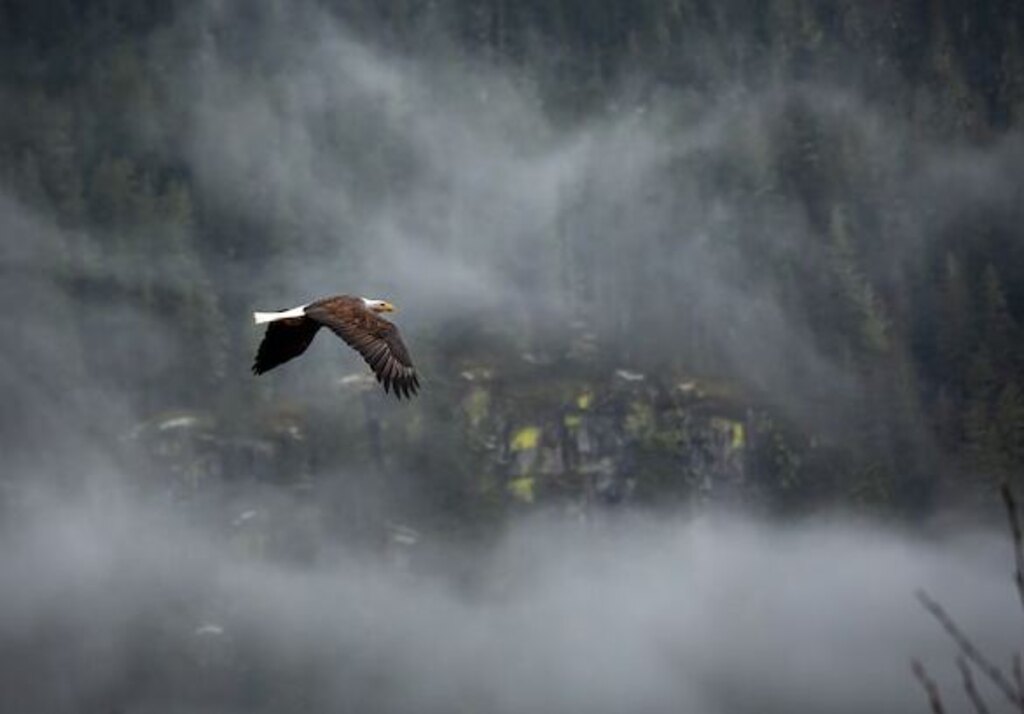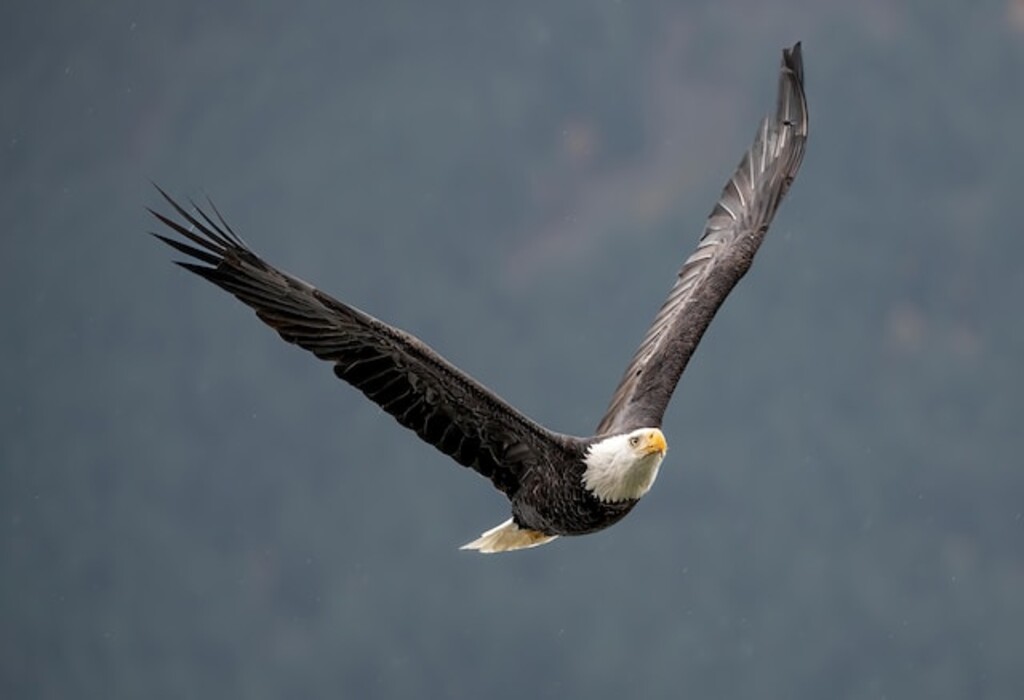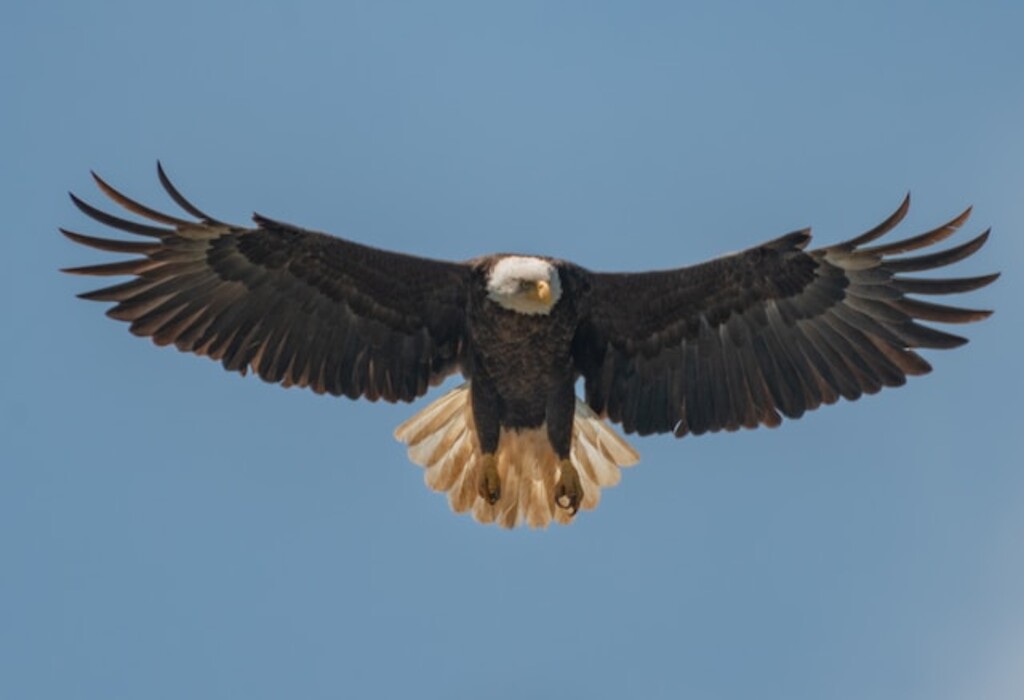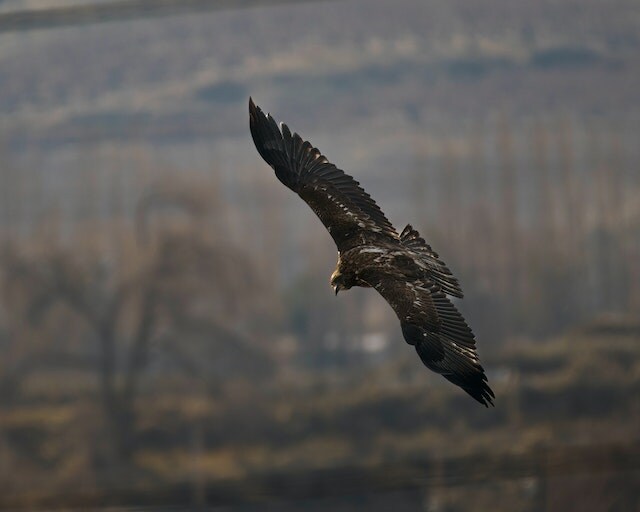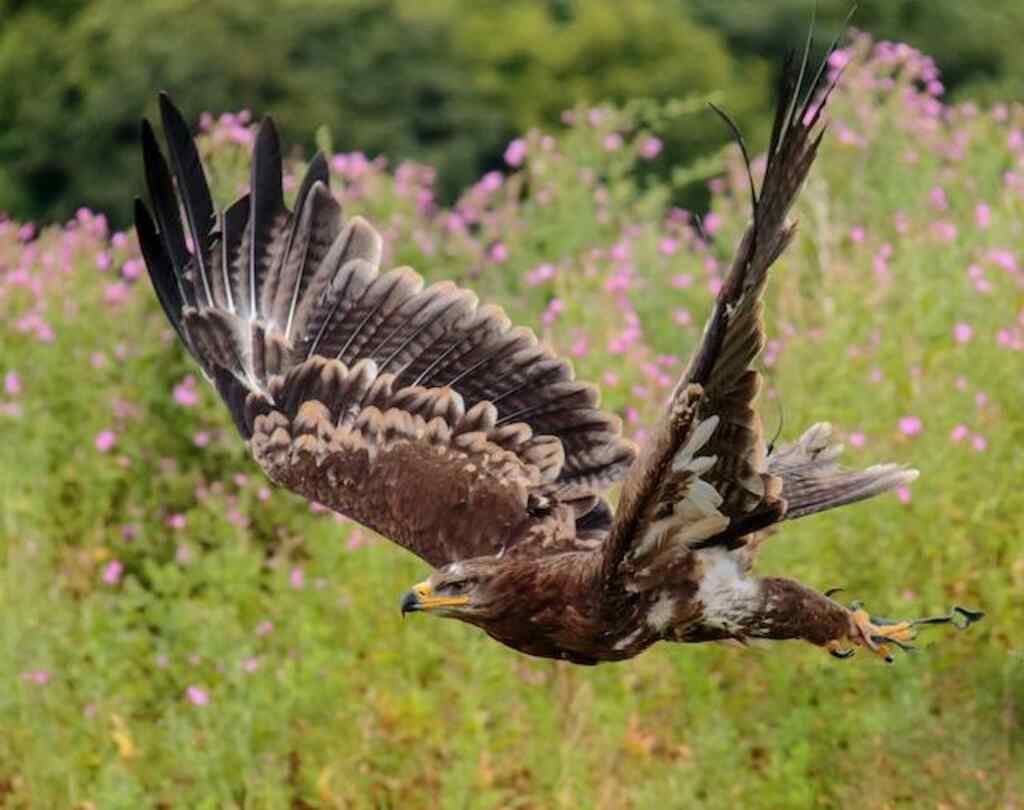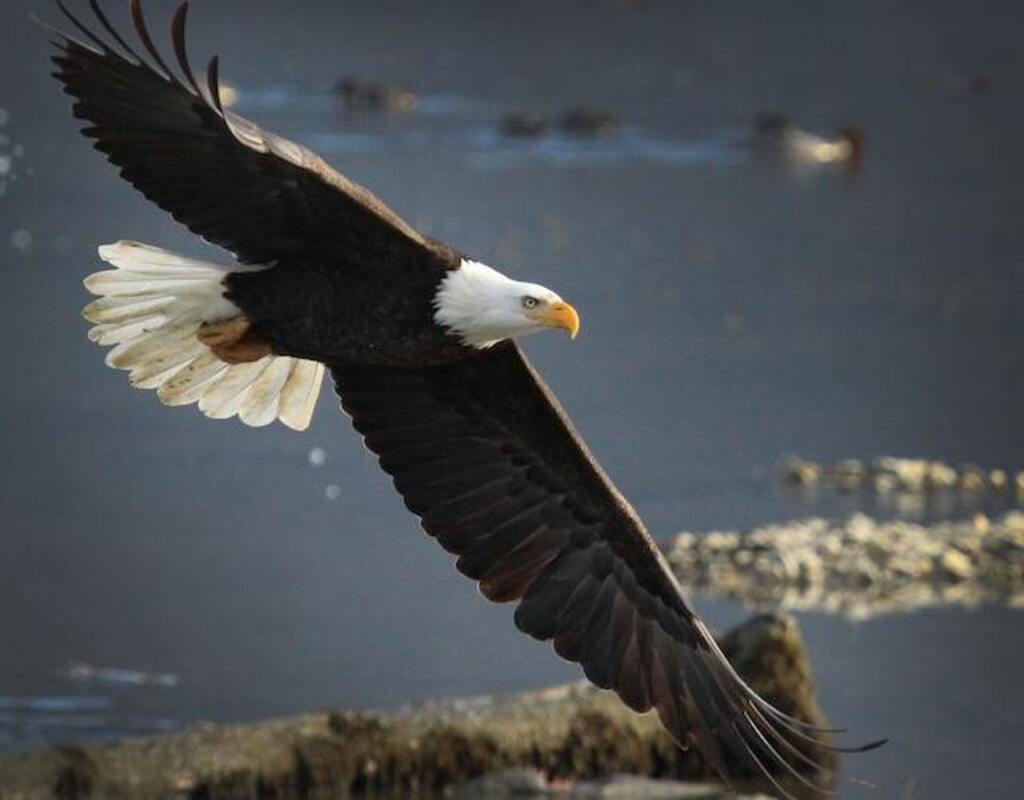In the realm of avian wonders, the soaring capabilities of eagles have captivated the human imagination for centuries. These majestic birds of prey possess a unique ability to glide effortlessly through the skies, their wings outstretched and motionless.
But just how long can an eagle soar without flapping?
According to scientific research, the average duration of eagle soaring can range anywhere from 30 minutes to several hours, depending on various factors such as wind conditions, thermals, and the bird’s physical condition.
This remarkable feat is made possible by the intricate anatomy of an eagle’s wings, which are specifically adapted for prolonged gliding.
Additionally, environmental factors, such as the availability of updrafts and air currents, play a crucial role in enabling these aerial acrobats to stay aloft.
The age and experience of an eagle also influence its soaring capabilities, as younger birds may have less stamina compared to their older counterparts.
Join us as we delve into the fascinating world of eagle soaring, exploring the science behind this extraordinary phenomenon and uncovering the secrets behind their seemingly limitless freedom in the sky.
Table of Contents
- 1 Key Takeaways
- 2 How Long Can An Eagle Soar Without Flapping
- 3 The Anatomy of an Eagle’s Wings
- 4 The Science Behind Gliding
- 5 The Duration of Soaring
- 6 Adaptations for Extended Soaring
- 7 Environmental Factors
- 8 Training and Conditioning
- 9 The Role of Age and Experience
- 10 The Relationship Between Soaring and Hunting
- 11 The Limits of Soaring
- 12 The Majesty of Eagle Soaring
- 13 Frequently Asked Questions
- 13.1 How many different species of eagle are capable of soaring for extended periods without flapping?
- 13.2 Can eagles soar at higher altitudes than other birds?
- 13.3 Do eagles need to eat or drink while they are soaring?
- 13.4 Are there any specific weather conditions that are best for eagle soaring?
- 13.5 How do eagles navigate and maintain their position while soaring?
- 14 Conclusion
- 15 Author
Key Takeaways
- Eagles have specialized wing adaptations, such as a large surface area and high aspect ratio, that enable them to soar without flapping for extended periods of time.
- Environmental factors, such as wind conditions and thermals, play a crucial role in enabling eagles to stay aloft and soar for several hours.
- Eagles utilize thermals and updrafts to gain altitude and maintain flight, conserving energy while searching for prey or traveling long distances.
- The age and experience of an eagle can affect its soaring capabilities, with adults being able to soar effortlessly without flapping, while juveniles rely more on flapping their wings to sustain flight.
How Long Can An Eagle Soar Without Flapping
Eagles can soar without flapping for hours. They utilize thermals and updrafts, showcasing graceful and precise flight.
Large wings and keen eyesight aid their exceptional flying abilities, allowing them to spot prey from great distances. This natural adaptation enables eagles to travel vast distances with ease.
The Anatomy of an Eagle’s Wings
The wings of an eagle possess a unique anatomical structure that enables it to soar for extended periods without the need for flapping.
The wing structure of an eagle is characterized by its large surface area and a high aspect ratio, allowing for efficient lift generation and reduced drag.
The eagle’s primary feathers are long and sturdy, providing stability and control during flight. Additionally, the arrangement of the feathers on the wings creates a smooth surface that minimizes turbulence.
The flight mechanics of an eagle involve utilizing thermals, which are updrafts of warm air, to gain altitude and maintain flight. By circling within these thermals, the eagle can conserve energy and stay aloft for prolonged periods.
This understanding of the wing structure and flight mechanics of an eagle lays the foundation for comprehending the science behind gliding.
The Science Behind Gliding
Gliding in birds is a fascinating phenomenon, as exemplified by the ability of certain species to maintain sustained flight for extended periods utilizing only the natural forces of air currents.
In order to achieve this, birds, including eagles, have evolved specific wing adaptations that allow them to optimize their gliding abilities.
Eagles have long, broad wings that enable them to generate lift and glide efficiently. These wings are designed to reduce drag and increase stability during flight.
The primary feathers at the end of their wings can be adjusted to control airflow, allowing them to maneuver and maintain altitude.
Additionally, eagles have a high aspect ratio, meaning their wings are long and narrow, which further enhances their gliding capabilities.
By taking advantage of updrafts and thermals, eagles can soar for long periods without flapping their wings.
This ability to glide effortlessly enables them to conserve energy while searching for prey or traveling long distances.
Transitioning into the next section about the duration of soaring, it is important to understand how eagles maximize their time in the air without expending excessive energy.
The Duration of Soaring
The duration of soaring in eagles can vary depending on several factors. On average, eagles can soar for several hours without flapping their wings, with some species able to stay airborne for up to 6 hours.
However, the actual duration of flight can be influenced by factors such as wind conditions, thermals, and the bird’s energy reserves.
Additionally, record-breaking flights have been observed, with some eagles covering distances of over 300 miles in a single flight.
Average duration of flight
On average, the duration of flight for an eagle in soaring mode can be quite remarkable. Eagles have evolved unique wing structures that enable them to stay airborne for extended periods without flapping their wings.
Their long, broad wings, combined with the ability to adjust the angle of their flight feathers, allow them to effectively use rising air currents to stay aloft.
Additionally, eagles rely on their keen sense of wind patterns to locate thermals and updrafts, which provide the necessary lift for sustained flight.
These factors, along with the eagle’s exceptional maneuverability in the air, contribute to their ability to soar for several hours at a time.
Understanding the average duration of an eagle’s flight is crucial in determining the factors that affect flight time, such as wind strength, weather conditions, and the availability of thermals.
Factors that affect flight time
Factors that influence the duration of an eagle’s flight include their unique wing structures, which allow them to maintain sustained aerial movement while conserving energy.
The wings of an eagle are long and broad, providing a large surface area that generates lift as the bird soars.
This, combined with their strong flight muscles, enables them to glide for extended periods without flapping their wings.
Additionally, eagles have specialized feathers that help them adjust their wing shape to optimize flight efficiency.
They also take advantage of wind patterns, such as updrafts and thermals, which provide additional lift and enable them to cover longer distances.
By utilizing these factors, eagles can soar for hours without flapping, maximizing their flight time.
This understanding of their wing structure and wind patterns sets the stage for exploring the realm of record-breaking flights.
Record-breaking flights
Record-breaking flights have captivated the fascination of aviation enthusiasts and researchers alike, shedding light on the remarkable capabilities of these majestic birds in the realm of aerial endurance.
When it comes to record-breaking flights, the wing morphology of eagles plays a crucial role. Firstly, a larger wing area enables the bird to generate more lift, allowing it to stay aloft for longer periods.
Secondly, the shape of the wings, with their broad and rounded tips, helps to reduce drag and increase efficiency during flight.
Lastly, the aspect ratio of the wings, which refers to the length and narrowness of the wings, allows eagles to glide effortlessly through the air.
These adaptations enable eagles to soar for extended periods without flapping, showcasing their extraordinary ability to harness the power of the wind.
Transitioning into the subsequent section about ‘adaptations for extended soaring’, eagles have also developed other physiological and behavioral adaptations to further enhance their aerial endurance.
Adaptations for Extended Soaring
This discussion will focus on the adaptations for extended soaring in eagles, specifically regarding wing morphology, energy conservation strategies, and feeding and hunting techniques.
Wing morphology plays a crucial role in enabling eagles to soar for extended periods without flapping their wings, as their long and broad wings provide ample lift and stability.
Energy conservation strategies, such as using thermals and updrafts, allow eagles to minimize energy expenditure and sustain their flight.
Additionally, their feeding and hunting techniques, such as scavenging and opportunistic hunting, ensure a steady supply of food to support their prolonged soaring behavior.
Wing morphology
Wing morphology plays a crucial role in determining the duration an eagle can soar without flapping, with wingspans ranging from 1.8 to 2.5 meters, allowing for efficient gliding and minimizing energy expenditure.
The wing structure of an eagle is optimized for prolonged flight, featuring long and broad wings that provide ample surface area for generating lift.
This enables the eagle to effortlessly ride thermals and updrafts, utilizing dynamic soaring techniques to maintain altitude and cover vast distances.
The wings are also equipped with specialized feathers, such as primary and secondary flight feathers, which aid in maneuverability and control during flight.
These adaptations allow eagles to soar for extended periods without the need for flapping, conserving energy for hunting and other essential activities.
Transitioning into the subsequent section on energy conservation strategies, it is important to understand how eagles maximize their flight efficiency to sustain prolonged soaring.
Energy conservation strategies
The previous subtopic explored the wing morphology of eagles and how their unique features contribute to their flight capabilities.
Now, let’s delve into the energy conservation strategies employed by these magnificent birds. One key aspect is their wing shape, which allows them to soar effortlessly for extended periods without flapping.
The large, broad wings create a high lift-to-drag ratio, enabling the eagle to harness air currents effectively.
By utilizing thermals and updrafts, these birds can gain altitude without expending much energy.
Thermals are columns of warm, rising air, while updrafts are created by wind blowing against a hillside or cliff.
This energy-saving technique allows eagles to cover vast distances while conserving valuable energy resources.
Understanding these adaptations sheds light on the remarkable efficiency and endurance of these aerial predators.
Transitioning into the subsequent section on feeding and hunting techniques, we can explore how eagles utilize their exceptional flight skills in pursuit of prey.
Feeding and hunting techniques
To maximize their hunting success, eagles employ a variety of feeding and hunting techniques that leverage their exceptional flight skills.
Eagles are known for their powerful talons and sharp beaks, which enable them to catch and kill prey.
They use a combination of soaring and gliding to search for potential targets from high vantage points, such as cliffs or tall trees.
Once they spot their prey, they dive with incredible speed and precision, using their sharp eyesight to accurately strike their target.
Eagles also use stealth as a hunting strategy, silently approaching their prey to minimize the chances of detection.
In addition, they are known to steal food from other birds, using their agility and speed to snatch away their prey.
These feeding and hunting techniques allow eagles to efficiently secure their meals in their natural environment.
Transitioning to the subsequent section about ‘environmental factors’, the feeding and hunting techniques of eagles are influenced by various environmental factors.
Environmental Factors
The ability of an eagle to soar without flapping its wings for extended periods is greatly influenced by various environmental factors.
Weather conditions play a crucial role, as strong winds and thermals provide the necessary lift for soaring.
The geographic location of the eagle also affects its ability to soar, as certain regions have more favorable wind patterns and thermal activity.
Additionally, the availability of updrafts, which are columns of rising air, is essential for sustained soaring flight as they help the eagle maintain its altitude and conserve energy.
Weather conditions
Under various weather conditions, an eagle can effortlessly glide through the sky without flapping its wings for extended periods of time, resembling a majestic sculpture gracefully suspended in the air. This remarkable ability is made possible by the unique wing structure and the utilization of wind patterns.
To understand how an eagle can soar without flapping, it is essential to consider the following factors:
- Wing structure: The eagle’s broad wingspan and strong flight feathers allow it to generate lift and maintain altitude with minimal effort.
- Wind patterns: Eagles take advantage of thermal updrafts, which are columns of warm air that rise from the ground, to gain altitude and stay aloft for longer durations.
- Air density: Eagles prefer to soar in areas with lower air density, such as at higher altitudes or near mountains, as it offers less resistance and allows them to glide more efficiently.
- Weather conditions: Favorable weather conditions, such as gentle winds and clear skies, provide optimal opportunities for eagles to soar without flapping.
Considering the influence of weather conditions, the subsequent section will explore the impact of geographic location on an eagle’s soaring capabilities.
Geographic location
In considering the duration of an eagle’s soaring without flapping, the geographic location plays a significant role. Eagles have a wide geographic range, with different species inhabiting various regions across the globe.
This diversity in the eagle’s habitat is influenced by factors such as climate, availability of prey, and suitable nesting sites.
Furthermore, eagles exhibit distinct migration patterns, with some species traveling long distances in search of favorable conditions.
For instance, the bald eagle, found in North America, undertakes extensive migrations, moving from northern regions to more temperate areas during winter.
These migrations allow eagles to access abundant food resources and avoid harsh weather conditions.
Understanding the geographic range and migration patterns of eagles is crucial in determining their ability to soar without flapping.
The subsequent section will delve into another essential factor: the availability of updrafts.
Availability of updrafts
Availability of updrafts greatly influences the soaring capabilities of eagles, as they rely on these upward air currents to maintain their flight and conserve energy. Updraft patterns play a crucial role in determining the success of an eagle’s flight.
Eagles have the ability to locate and take advantage of updrafts, which are created by wind currents interacting with the terrain.
These updrafts provide the necessary lift for the eagle to stay airborne without flapping their wings.
The availability of updrafts can vary depending on factors such as the geographical location and weather conditions.
Understanding the patterns of updrafts and wind currents is essential for eagles to optimize their flight efficiency and prolong their soaring time.
Transitioning to the subsequent section on ‘training and conditioning’, eagles rely on both natural instincts and learned behaviors to make the most of the updrafts they encounter during their flights.
Training and Conditioning
Trainers and researchers focus on the conditioning and training methods to enhance the endurance of eagles in flight, aiming to maximize their flight duration without the need for flapping.
Training techniques are designed to build the strength and stamina of the eagle’s flight muscles, allowing them to soar effortlessly for longer periods.
These techniques include exercises that target specific muscle groups involved in flight, such as the pectoral muscles responsible for wing movement.
By gradually increasing the intensity and duration of these exercises, trainers aim to improve the overall muscle development and endurance of the eagle.
Additionally, conditioning programs may involve simulated flight exercises and controlled gliding to mimic the natural flight patterns of eagles.
These training methods are essential to prepare eagles for extended flights and reduce the need for flapping.
Transitioning into the subsequent section about the role of age and experience, it is crucial to consider how these factors influence an eagle’s endurance and flight capabilities.
The Role of Age and Experience
The role of age and experience plays a significant role in the flight abilities of eagles.
Juveniles and adults differ in their flight capabilities, with adults generally having better flight skills and endurance.
Additionally, eagles have the ability to learn from older generations, which enables them to improve their flight techniques and strategies over time.
Lifelong learning and improvement are essential for eagles, as they continue to refine their flight abilities throughout their lives.
Differences in flight abilities between juveniles and adults
Juvenile and adult eagles exhibit distinct flight abilities, showcasing contrasting elegance and mastery of the skies.
One key difference lies in their wing development. Juveniles possess shorter and less developed wings, which require more effort to maintain flight.
They often rely on flapping their wings frequently to sustain their flight.
In contrast, adult eagles have longer and more mature wings that enable them to soar effortlessly for extended periods without flapping.
Their well-developed flight muscles and efficient aerodynamics allow them to ride on thermals, using minimal energy expenditure.
This difference in flight behavior highlights the importance of age and experience in the flight capabilities of eagles.
By observing and learning from older generations, juveniles can acquire the necessary skills to enhance their flight abilities and eventually achieve the grace and mastery exhibited by adult eagles.
Learning from older generations
By observing the wisdom passed down from previous generations, young eagles can gain valuable insights that elevate their flight skills to new heights.
Learning from elders is a crucial aspect of an eagle’s development, as it allows them to benefit from the wisdom of age.
Older eagles possess a wealth of knowledge and experience that they pass on to the younger ones, enabling them to navigate the skies with greater efficiency and grace.
Through close observation and imitation, young eagles can learn essential techniques such as thermaling, a skill that allows them to soar effortlessly without expending much energy.
This process of learning from older generations ensures that each new generation of eagles builds upon the knowledge and expertise of those that came before them, leading to continuous improvement and lifelong learning.
Consequently, young eagles can embark on a journey of self-improvement and mastery of the skies.
Lifelong learning and improvement
Continuously seeking knowledge and refining their skills, young eagles engage in a perpetual journey of improvement and lifelong learning.
Age diversity within the eagle community ensures that the knowledge and experiences of older generations are passed down to the younger ones, creating a cycle of continuous improvement.
Through observation and imitation, young eagles learn valuable skills such as hunting techniques, flight patterns, and navigation strategies.
They also benefit from the wisdom and guidance provided by the older eagles, who have honed their abilities over the years.
Lifelong learning allows young eagles to adapt to changing environments, develop innovative strategies, and overcome challenges they encounter.
This constant quest for improvement enables them to thrive and maintain their freedom in the sky.
Transitioning to the subsequent section about ‘the relationship between soaring and hunting’, eagles’ ability to soar without flapping is deeply intertwined with their hunting prowess.
The Relationship Between Soaring and Hunting
In the realm of avian hunting, the art of soaring becomes a graceful dance between predator and prey.
Eagles, known for their impressive hunting techniques, have evolved energy conservation strategies that enable them to soar for extended periods without flapping their wings.
By utilizing thermal updrafts and wind currents, eagles can effortlessly glide through the air, conserving precious energy while surveying the landscape for potential prey.
This symbiotic relationship between soaring and hunting allows eagles to cover vast distances and maintain aerial surveillance for extended periods.
To illustrate this concept, the following table provides a visual representation of the relationship between soaring and hunting in eagles:
| Hunting Techniques | Energy Conservation Strategies |
|---|---|
| Aerial surveillance | Utilizing thermal updrafts |
| Ambush hunting | Utilizing wind currents |
| Dive bombing | Gliding effortlessly |
| Stooping | Maintaining steady flight |
| Speed hunting | Minimizing wing flapping |
Understanding the limits of soaring is essential for comprehending the remarkable abilities of these majestic birds of prey.
The Limits of Soaring
The limits of soaring in birds, such as eagles, are determined by various factors.
First, physical limitations of flight play a crucial role. Birds have certain anatomical features that restrict their ability to soar for extended periods without flapping their wings, such as muscle fatigue and the need for oxygen intake.
Second, environmental constraints can impact soaring capabilities, including wind speed and direction, thermals, and air turbulence.
Lastly, individual variations and capabilities among birds can also influence their ability to soar, as different species or individuals may have different flight strategies and energy requirements.
Physical limitations of flight
Birds of prey, such as eagles, possess remarkable physical abilities that allow them to soar effortlessly through the sky for extended periods of time.
Their wing shape plays a crucial role in their ability to stay aloft without flapping. The wings of eagles are long and broad, providing a large surface area that generates lift as air flows over them.
This shape enables them to take advantage of rising air currents, known as thermals, which allow them to gain altitude and travel long distances without expending much energy.
Additionally, the strong muscles in their wings enable them to maintain stability and control while soaring.
However, despite these physical advantages, eagles are still subject to environmental constraints that can limit their ability to soar continuously. These constraints will be discussed in the subsequent section.
Environmental constraints
Environmental factors can impose limitations on the sustained flight of eagles, hindering their ability to navigate through the sky effortlessly. These factors include energy expenditure and wind patterns.
- Energy Expenditure: Eagles need to maintain an adequate energy balance to stay airborne for extended periods. Soaring without flapping allows them to conserve energy by utilizing rising air currents, known as thermals, to gain altitude. However, if there is a scarcity of thermals in the environment, eagles may struggle to sustain their flight.
- Wind Patterns: Eagles rely on wind patterns for efficient soaring. They use updrafts created by wind hitting slopes or obstacles, such as cliffs or trees, to gain lift and stay aloft. However, certain wind conditions, such as strong headwinds or turbulent air currents, can make it challenging for eagles to soar without flapping.
Understanding these environmental constraints is crucial to comprehending the limits of eagle flight. Transitioning into the subsequent section about individual variations and capabilities, it becomes apparent that these environmental factors interact with the unique characteristics of each eagle.
Individual variations and capabilities
Individual variations and capabilities of eagles are influenced by a diverse range of factors, including genetic traits, age, and previous flight experience, which collectively shape their ability to navigate and adapt to changing flight conditions.
Adaptation strategies and hunting techniques employed by eagles allow them to soar effortlessly for extended periods without flapping their wings.
These strategies include utilizing thermals, updrafts, and wind currents to gain altitude and maintain flight, as well as adjusting wing positions and body posture to optimize efficiency.
Furthermore, individual eagles may exhibit variations in wing morphology and muscle strength, which can affect their ability to sustain soaring flight.
Understanding these variations and capabilities is crucial for studying eagle behavior and ecology, as it provides insights into their ecological niche and survival strategies.
Transitioning to the subsequent section about the majesty of eagle soaring, their incredible airborne abilities captivate and inspire observers worldwide.
The Majesty of Eagle Soaring
The awe-inspiring sight of an eagle soaring across the sky effortlessly captivates the observer’s imagination, leaving them in awe of its majestic flight.
The gracefulness of its flight and the art of gliding are truly remarkable.
The eagle utilizes its keen eyesight to locate thermals, which are columns of warm air rising from the earth’s surface.
By skillfully maneuvering within these thermals, the eagle is able to gain altitude without expending much energy.
As it ascends higher, the eagle expertly adjusts its wings and tail to maintain stability and control.
The elegant curvature of its wings allows for efficient lift, while the spread tail acts as a rudder, aiding in steering.
The eagle’s flight is a beautiful dance with the wind, as it effortlessly soars for hours, embodying the essence of freedom.
Frequently Asked Questions
How many different species of eagle are capable of soaring for extended periods without flapping?
Several eagle species are capable of soaring for extended periods without flapping their wings. This skill provides them with numerous benefits, such as energy conservation, enhanced visibility for hunting, and efficient travel over large distances.
Can eagles soar at higher altitudes than other birds?
Eagles are known for their exceptional flight abilities, including soaring at higher altitudes compared to other birds. This advantage is attributed to their flight patterns, which involve utilizing thermal updrafts and wind currents for sustained flight without flapping.
Do eagles need to eat or drink while they are soaring?
Eagles do not need to eat or drink while soaring due to their ability to conserve energy. They obtain nutrition from their previous meal and can go without food or water for extended periods of time.
Are there any specific weather conditions that are best for eagle soaring?
The ideal conditions and best time for eagle soaring involve a clear sky, gentle winds, and thermals rising from the ground. These thermals create updrafts, enabling the eagle to soar effortlessly for extended periods.
Eagle navigation involves utilizing thermals and updrafts to maintain their position while soaring. Thermals are columns of warm air that rise from the ground, providing upward lift, while updrafts are currents of air that flow upwards due to topographical features.
Conclusion
In conclusion, the majestic soaring abilities of eagles truly captivate our imagination.
Through their intricate wing structure and remarkable adaptations, these magnificent creatures are able to glide effortlessly through the skies, covering vast distances without the need to flap their wings.
However, despite their seemingly limitless capabilities, even the mighty eagle has its limitations.
Environmental factors, age, and experience all play a role in determining the duration and success of their soaring endeavors.
So next time you witness an eagle soaring high above, remember the scientific marvel behind its flight, a marvel that, ironically, reminds us of our own earthly limitations.

